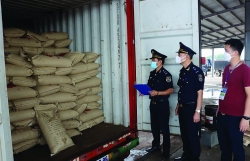VCN – The growth momentum of the fruit and vegetable industry is not expected to break through in 2022, if China does not remove the “Zero Covid” policy.
 |
| Illustrative photo. Photo: Nguyen Hien |
According to statistics of the General Department of Customs, in July 2022, the export of vegetables and fruits grew for the second consecutive month, estimated at $260 million, up 0.3% compared to June 2022. In the first seven months of 2022, the total export value of vegetables and fruits was estimated at US$1.7 billion, down 17.1% over the same period in 2021.
Regarding the perspective of export markets, the Import-Export Department (Ministry of Industry and Trade) said vegetables and fruits exported to the Americas and Europe will increase their proportion in the first half of 2022.
Statistics from the International Trade Center (ITC) show that the US is the world’s largest fruit and vegetable import market. In the first five months of 2022, the US’ import of this product reached US$25.5 billion, up 17.2% over the same period in 2021. In which, imports from Vietnam only accounted for 0.75% of the total imports value, an increase of 0.15 percentage points over the same period in 2021. Therefore, the potential for exporting vegetables and fruits to the US market is very large.
The US and Europe are regions with strict standards for fruit and vegetable products. When vegetables and fruits can be exported to these markets, Vietnam’s fruit and vegetable industry is expected to be exported to many other markets and reduce dependence on China, which is Vietnam’s leading fruit and vegetable export market.
However, when exporting to these markets, Vietnamese enterprises need to ensure quality, uniformity and stability in each export shipment so that retailers can place long-term orders.
While fruit and vegetable exports recorded positive signals in the Americas and Europe markets in the first half of the year, the proportion of exports to Asia was on a downward trend. Because the value of exports to the largest market, China, decreased sharply.
China is currently the third largest fruit and vegetable import market in the world. According to statistics from China Customs, China’s imports of this item in the first five months of 2022 reached US$10.3 billion, up 11.1% over the same period in 2021.
The proportion of imports from Vietnam accounts for 9.5% of the total value of China’s fruit and vegetable imports.
China is an important export market for Vietnamese fruit and vegetables. However, China is no longer an “easy” market. For each type of fruit, China’s Inspection and Quarantine Agency will conduct a sanitary and epidemiological risk assessment, then decide to allow imports into China.
However, according to the Import-Export Department, from now to the end of the year, the Chinese market is showing many positive signals. Customs clearance of vegetables and fruits through land border gates with China is more convenient.
Vietnam’s fruit and vegetable exports have many growth prospects for this market, if the disease situation is controlled because the demand for vegetables and fruits in China will increase sharply.
The positive signal is quite clear that a number of Vietnamese fruit and vegetable products have recently been licensed for official export to China, contributing to raising the export value of vegetables and fruits.
Specifically, from July 1, 2022, the Chinese side has agreed to pilot import of Vietnamese passion fruit through border gates in China’s Guangxi province. On July 11, 2022, the General Administration of Customs of China signed a Protocol on phytosanitary requirements for durian exported from Vietnam to China.
The Import-Export Department recommends that businesses in Vietnam’s fruit and vegetable industry must change their production methods towards safety, have specific standards, manage farming processes, and meet the requirements of traceability to promote exports to the Chinese market in the near future.
 | Exporting in Mong Cai – a “safe green zone” VCN – In the past month, at clearance points in Mong Cai, Quang Ninh, Customs forces have … |
In addition, it is necessary to improve the quality of agricultural products, meet the import standards of “fastidious” markets, combine with diversifying customers and export markets for agricultural products, avoiding dependence on the traditional market.
By Nguyen Thanh/ Quynh Lan
